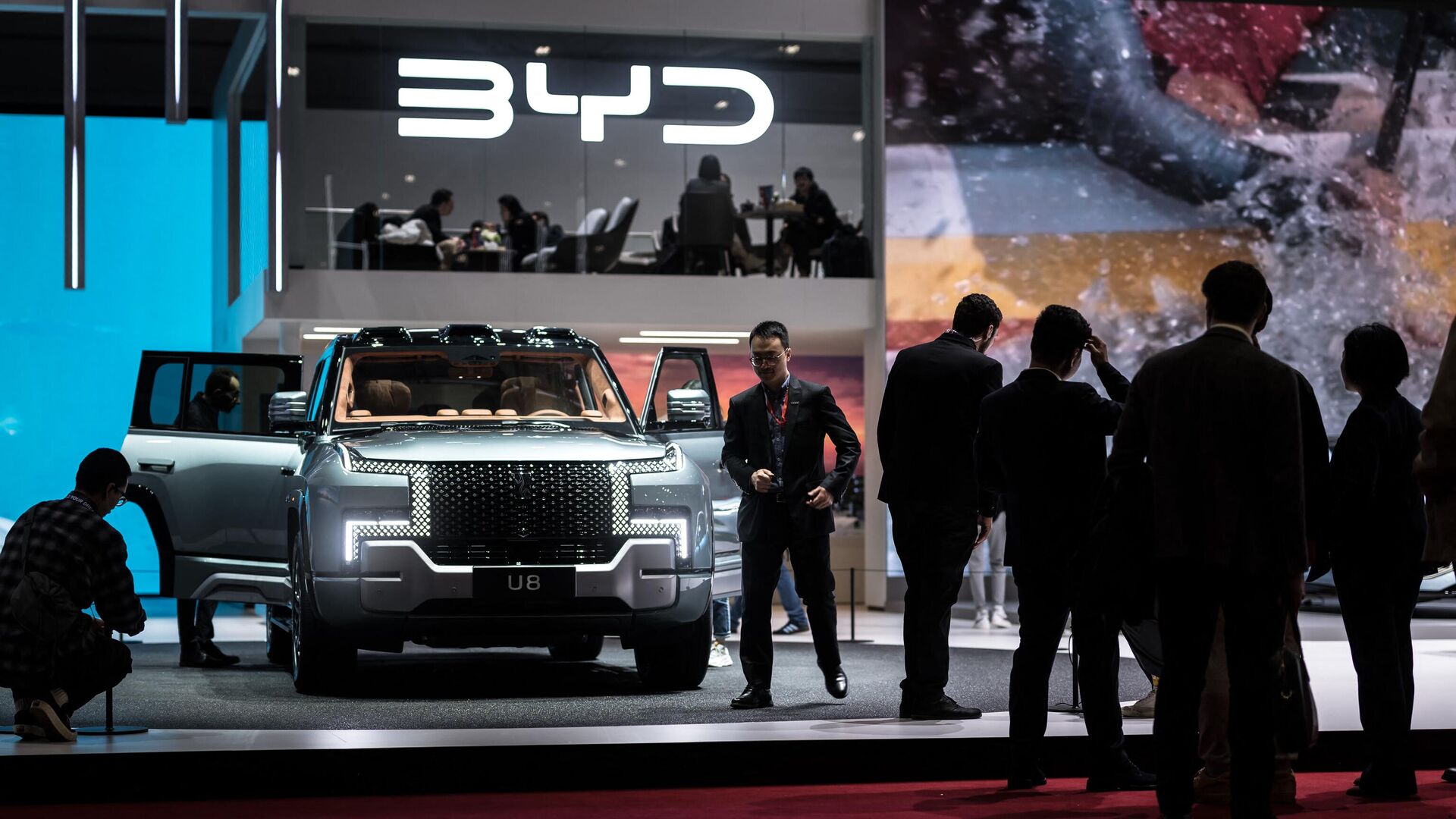https://sputnikglobe.com/20240303/west-braces-for-new-china-shock-as-beijing-brings-back-export-oriented-development-strategy-1117106302.html
West Braces for New ‘China Shock’ as Beijing Brings Back Export-Oriented Development Strategy
West Braces for New ‘China Shock’ as Beijing Brings Back Export-Oriented Development Strategy
Sputnik International
The People’s Republic was anointed the global ‘workshop of the world’ in the 2000s following its accession into the World Trade Organization in 2001, with its manufacturing exports edging out the US and European competition thanks to a combination of Western corporate executives’ greed and a shrewd Chinese play to promote exports through subsidies.
2024-03-03T15:59+0000
2024-03-03T15:59+0000
2024-03-03T16:00+0000
economy
donald trump
joe biden
business
china
world trade organization (wto)
economy
https://cdn1.img.sputnikglobe.com/img/07e8/03/03/1117106052_0:160:3072:1888_1920x0_80_0_0_67e727cf7bff23e93f197d54b7dd95af.jpg
America’s leading business newspaper is urging countries around the world to prepare for a second ‘China Shock’ as the Asian manufacturing giant ramps up the exports of competitively priced, high-value manufacturing goods after satiating its home market.The Wall Street Journal fears the 'sequel' to the early 2000s Chinese export boom, which came at the cost of manufacturing jobs in the US and Europe, could be even more extensive than its original iteration, with the Asian nation now accounting for a much larger share of the world economy.According to the World Bank, China accounted for ‘just’ 10 percent of global manufacturing output and 5 percent of all goods exports two decades ago – compared with 31 percent and 14 percent in 2022, respectively.The newspaper expects the US, the European Union and Japan to put up a stiffer resistance to China’s manufacturing export boom this time around, with governments erecting tariff and other barriers and committing billions of dollars in subsidies to ‘strategic’ domestic industries.US President Joe Biden has largely continued the tariff war against Chinese goods launched by his predecessor, Donald Trump, in 2018, and Trump has gone further, warning that he might to target Chinese goods with tariffs of 60 percent or higher if he wins in November.China has poured hundreds of billions of dollars into industrial and consumer research and development in recent years, with R&D as a percentage of GDP hitting around 2.5 percent in 2022, and the country making impressive strides into the presumed technologies of the future, from computing and aerospace to vehicles and renewable energy – with an eye to export surpluses abroad, all while maintaining its status as a leading manufacturer of lower-cost goods as well.
https://sputnikglobe.com/20240225/whos-laughing-now-chinas-shrewd-planning-paved-way-for-manufacturing-dominance-1116981963.html
https://sputnikglobe.com/20240209/germanys-economic-dilemmas-deepen-as-corporate-distress-takes-hold-1116662356.html
china
Sputnik International
feedback@sputniknews.com
+74956456601
MIA „Rossiya Segodnya“
2024
News
en_EN
Sputnik International
feedback@sputniknews.com
+74956456601
MIA „Rossiya Segodnya“
Sputnik International
feedback@sputniknews.com
+74956456601
MIA „Rossiya Segodnya“
what is china shock, will china take over the world economy, how did china take over global manufacturing
what is china shock, will china take over the world economy, how did china take over global manufacturing
West Braces for New ‘China Shock’ as Beijing Brings Back Export-Oriented Development Strategy
15:59 GMT 03.03.2024 (Updated: 16:00 GMT 03.03.2024) The People’s Republic was anointed the global ‘workshop of the world’ in the 2000s following its accession into the World Trade Organization in 2001, with its manufacturing exports edging out the US and European competition thanks to a combination of Western corporate executives’ greed and a shrewd Chinese play to promote exports through subsidies.
America’s leading business newspaper is urging countries around the world to prepare for a second ‘China Shock’ as the Asian manufacturing giant ramps up the exports of competitively priced, high-value manufacturing goods after satiating its home market.
The Wall Street Journal
fears the 'sequel' to the early 2000s Chinese export boom, which came at the cost of manufacturing jobs in the US and Europe, could be even more extensive than its original iteration, with the Asian nation now accounting for a much larger share of the world economy.
According to the World Bank, China accounted for ‘just’ 10 percent of global manufacturing output and 5 percent of all goods exports two decades ago – compared with 31 percent and 14 percent in 2022, respectively.
“The result” of a China Shock 2.0 “could be a world swimming in manufactured goods, and short of the spending power to buy them – a classic recipe for falling prices,” according to WSJ.
The newspaper expects the US, the European Union and Japan to put up a stiffer resistance to China’s manufacturing export boom this time around, with governments erecting tariff and other barriers and committing billions of dollars in subsidies to ‘strategic’ domestic industries.
US President Joe Biden has largely continued the tariff war against Chinese goods launched by his predecessor, Donald Trump, in 2018, and Trump has gone further, warning that he might to target Chinese goods with tariffs of 60 percent or higher if he wins in November.

25 February 2024, 23:06 GMT
“It won’t be the same China shock,” MIT professor David Autor, one of the authors of the original China shock concept, said. “The concerns are more fundamental” this time around, he warned, pointing out twenty years on since the original phenomenon, when the Asian nation produced things like toys, clothing, and furniture, China has learned to develop and manufacture vehicles, machinery and computer chips which rival their Western competitors.
China has poured hundreds of billions of dollars into industrial and consumer research and development in recent years, with R&D as a percentage of GDP hitting around 2.5 percent in 2022, and the country making impressive strides into the presumed technologies of the future, from computing and aerospace to vehicles and renewable energy – with an eye to export surpluses abroad, all while maintaining its status as a leading manufacturer of lower-cost goods as well.
The coming Chinese boom may help explain the urgency with which Washington has moved to siphon major industries from Europe beginning in 2022 after passing the Build Back Better Act in late 2021, with the legislation providing producers lavish subsidies for relocating their manufacturing operations to the United States. European producers have seen their competitiveness vis-à-vis the US and China shrivel over the past two years thanks to the crisis in Ukraine, including Brussels’ self-defeating restrictions on Russian pipeline energy in favor of more expensive liquid natural gas from overseas.

9 February 2024, 11:30 GMT




